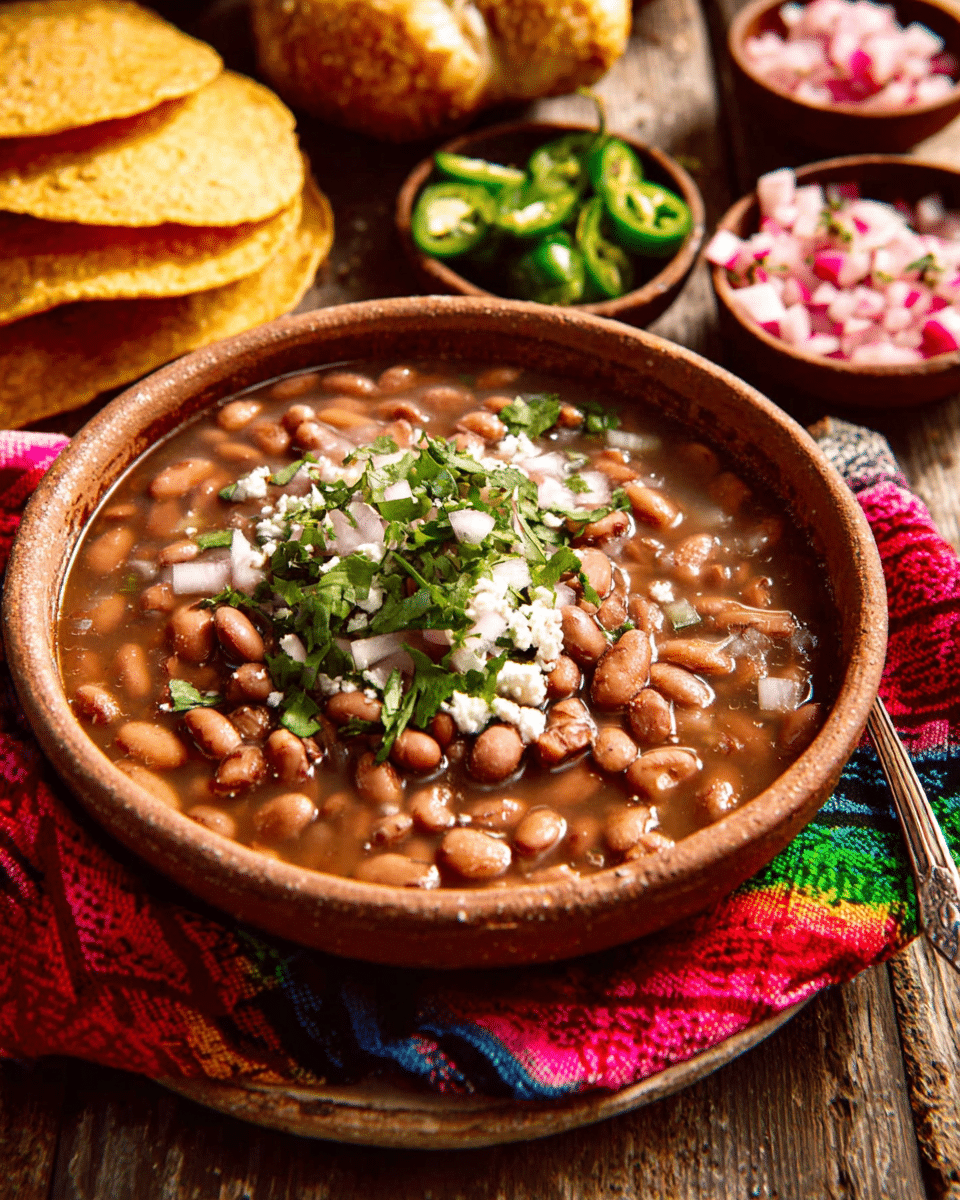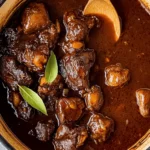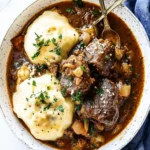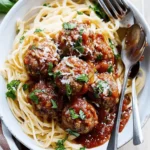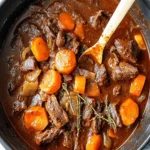Frijoles de Olla, or “beans in a pot,” is a traditional Mexican comfort dish that forms the foundation of many other iconic recipes. Typically made with simple, wholesome ingredients like pinto or black beans, onion, garlic, and herbs, this slow-cooked stew is flavorful and nourishing.
FULL RECIPE
Ingredients
- 2 cups dried pinto beans (or black beans), rinsed and sorted
- 8 cups water
- 1 small white onion, halved
- 3 garlic cloves, peeled
- 2 bay leaves
- 1 tablespoon salt (add toward the end of cooking)
- Optional: epazote sprig or 1 teaspoon dried epazote (for traditional flavor)
- Optional garnishes: chopped onion, cilantro, queso fresco, jalapeño slices
Directions
- Soak the beans (optional): For quicker cooking, soak the dried beans in water overnight or for at least 6 hours. Drain and rinse before cooking.
- Start cooking: In a large pot (olla), add the beans, 8 cups of water, onion, garlic, and bay leaves. Bring to a boil over high heat.
- Simmer: Once boiling, reduce the heat to low and simmer uncovered. Skim off any foam that rises to the top.
- Add epazote (optional): If using epazote, add it to the pot after about 30 minutes of simmering.
- Cook until tender: Continue simmering for 1.5 to 2.5 hours, or until the beans are soft and creamy. If needed, add more hot water to keep the beans covered.
- Season: Add salt near the end of cooking, once the beans are tender, to avoid toughening them. Stir well and adjust seasoning to taste.
- Serve: Ladle the beans with their broth into bowls. Serve plain or garnish with chopped onion, cilantro, queso fresco, or sliced jalapeños. Enjoy as-is or serve alongside rice, tortillas, or grilled meats.
Nutrition Facts
- Calories: 220
- Protein: 13g
- Fat: 1g
- Saturated Fat: 0g
- Carbohydrates: 40g
- Fiber: 12g
- Sugars: 1g
- Sodium: 400mg
- Cholesterol: 0mg
Traditional Cooking Methods
In its most authentic form, Frijoles de Olla is cooked slowly in a clay pot, or “olla de barro,” over an open flame or stovetop. The clay enhances the flavor by allowing the beans to cook evenly and absorb the earthy aroma. Though many now use stainless steel or enameled pots, the cooking method remains largely unchanged: a slow simmer that coaxes out the natural creaminess of the beans. Soaking the beans beforehand can reduce cooking time, but the magic lies in the patient, gentle cooking that allows the ingredients to develop deep, satisfying flavors.
Nutritional Benefits of Beans
One of the key reasons Frijoles de Olla is such a vital part of the Mexican diet is its outstanding nutritional profile. Beans are an excellent source of plant-based protein, fiber, and complex carbohydrates, making them ideal for maintaining energy levels and digestive health. They are also packed with essential minerals such as iron, potassium, magnesium, and folate. When paired with rice or tortillas, beans offer a complete amino acid profile—making them a powerful, meat-free protein source that supports muscle development, heart health, and blood sugar regulation.
Variations Across Regions
Though the foundational elements of Frijoles de Olla remain consistent, regional variations abound. In northern Mexico, pinto beans are most commonly used, while in the south, black beans take center stage. Some areas add aromatic herbs like epazote for flavor and digestion aid, while others enhance the broth with pork bones, chorizo, or even avocado leaves. These localized twists make the dish versatile and reflective of the regional identities within Mexican cuisine. Even among households, small changes in seasoning or garnishes create subtle yet meaningful differences.
Modern Cooking Adaptations
While the traditional method emphasizes slow cooking, modern conveniences have made the preparation of Frijoles de Olla more accessible. Electric pressure cookers and slow cookers allow for quicker or more hands-off methods without sacrificing flavor. Cooks can now achieve tender, flavorful beans in under an hour using a pressure cooker. For those with dietary restrictions or busy schedules, canned beans can be used as a shortcut, though the texture and depth of flavor may not match that of freshly prepared beans. Regardless of method, the essence of the dish remains intact.
Serving Suggestions
Frijoles de Olla is a flexible dish that can be served in numerous ways. It can be eaten as a light meal on its own, especially when accompanied by warm tortillas and a sprinkle of cheese. For a heartier plate, pair it with grilled meats, rice, or sautéed vegetables. The bean broth is also cherished for its comforting, soup-like quality, especially on colder days. Garnishes such as chopped onion, cilantro, jalapeños, or queso fresco can elevate both flavor and presentation, allowing diners to customize their bowl according to personal preference.
Popular Pairings
This bean stew complements a wide array of Mexican dishes. It pairs wonderfully with carne asada, enchiladas, tamales, or tacos, adding depth and balance to richer, spicier fare. A side of Mexican rice or esquites (street corn) offers a colorful and flavorful companion. For beverages, a glass of horchata or tamarind agua fresca enhances the comfort-food experience. Frijoles de Olla also works well in combination plates during celebrations, making it a versatile component of festive and everyday meals alike.
Storage and Reheating Tips
Frijoles de Olla store exceptionally well, and the flavor often deepens after a day or two in the fridge. Store leftovers in an airtight container for up to five days. They can also be frozen for up to three months. When reheating, do so gently over medium heat, adding a bit of water or broth if the beans have thickened too much. Microwave reheating is also effective for individual portions, though stirring periodically ensures even heating. Avoid overcooking during reheating, as it may cause the beans to become mushy or dry.
Creative Uses for Leftovers
Leftover Frijoles de Olla can be transformed into many delicious meals. Mash and refry them for traditional refried beans (frijoles refritos) to serve with tacos or tostadas. Add them to soups, stews, or even salads for extra protein. You can also use them as a filling for gorditas, burritos, or tamales. Some home cooks enjoy blending the beans and broth for a creamy soup base or using them as a hearty dip with tortilla chips. This adaptability ensures that nothing goes to waste, promoting sustainability in home cooking.
Tips for Enhancing Flavor
To enrich the flavor of Frijoles de Olla, consider layering aromatics and seasonings. Start with sautéed onions, garlic, or even bacon at the bottom of the pot before adding the beans and water. Herbs such as epazote, oregano, or thyme can infuse subtle notes, while a dash of cumin or chili powder offers a spicier touch. Adding a small piece of pork rind or smoked meat during cooking will give the broth a rich, umami dimension. Taste frequently as the beans cook and adjust the seasoning to ensure a well-balanced flavor profile.
Advertisement
Conclusion
Frijoles de Olla is more than a dish it’s a culinary tradition that speaks to the heart of Mexican cuisine. Its simplicity is matched only by its versatility, nourishing generations with both flavor and nutrition. From family dinners to national celebrations, this comforting bean stew remains a beloved fixture at the table. Whether cooked in a clay pot over hours or whipped up in a modern pressure cooker, the soul of Frijoles de Olla endures.

